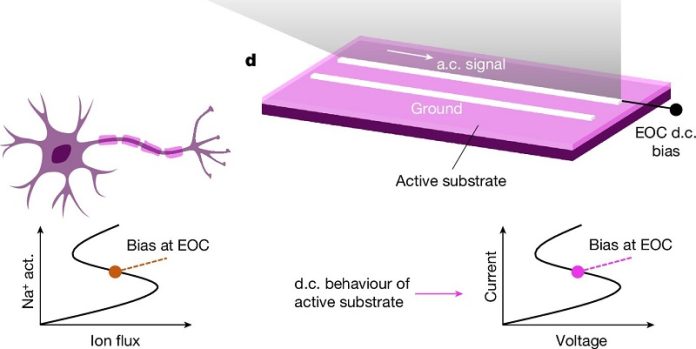
A team of researchers from Texas A&M University, Sandia National Labs, and Stanford University have discovered a new class of materials that mimic the way brain cells send electrical signals.
This breakthrough could help make future computers and artificial intelligence (AI) systems more energy efficient.
The study, published in Nature, shows that these materials behave like axons, the part of a nerve cell responsible for carrying signals in the brain.
In current computer systems, electrical signals traveling through metallic wires lose strength due to the resistance of the metal.
As a result, amplifiers are needed to boost the signals, which costs energy, time, and space. This is a problem in modern computer chips, where about 30 miles of copper wires are used to transmit these signals.
To find a solution, the researchers looked to the brain for inspiration. Axons in the brain can carry signals over long distances without the need for amplifiers, even though they are made of resistive organic materials, unlike the metals used in electronics.
“Biology does this differently,” said Dr. Tim Brown, the lead author of the study and a researcher at Sandia National Labs. “In the brain, signals can travel across long distances through axons without losing strength or needing a boost.”
The new materials discovered in this study work similarly to axons. They exist in a “primed” state, ready to amplify an electrical pulse as it moves along.
The researchers used a material called lanthanum cobalt oxide, which becomes more conductive when heated. The heat generated by a passing signal causes the material to amplify the signal, creating a feedback loop that keeps the signal strong.
This behavior is unique and not seen in ordinary electrical components like resistors or capacitors. The material can even produce unusual effects, such as amplifying small changes in electrical signals and showing negative electrical resistance. It also maintains stability, meaning the signal doesn’t break down or overheat.
According to Dr. Patrick Shamberger, an associate professor at Texas A&M, these materials could be key in creating more efficient computing systems. With data centers projected to use 8% of the United States’ energy by 2030, finding ways to reduce energy use in computing is critical. AI is also expected to increase energy demand, making energy-efficient technologies even more important.
In the long term, this research represents a step toward using biology as inspiration to design dynamic materials for computing. By mimicking how the brain works, these materials could help revolutionize how future computers and AI systems are built, making them more powerful and less energy-hungry.
Source: Texas A&M University.



